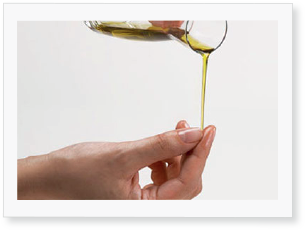PARAFFIN WAX

Hands are dipped in melted paraffin wax for softening and moisturizing.
This type of wax can be heated to temperatures over 100 degrees Fahrenheit without burning or injuring the hand.
The intense heat allows for deeper absorption or emollients and essential oils. It is usually infused with botanical ingredients such as aloe vera, chamomile, tea tree oil and azulene.
Fruit waxes are often used in salons.
Hands are dipped more than once to allow a thicker wax coat to form, allowing the coat to stay warm for longer and less likely to break or tear prematurely.
Then the hands are wrapped in either plastic, aluminum foil, or a special type of plastic bag or glove, then covered with towel or special mitten to retain warmth.
HOT OIL

The intense heat allows for deeper absorption or emollients and essential oils.
This is a specific type of manicure that cleans the cuticles
and softens them with oil.
It works well for dry skin and nails that are brittle as it improves both by leaving them soft and pliable.
Mineral oil, olive oil, or commercial preparation in an electric heater can be used for this type of manicure.
CALLUS REMOVER

A callus is a hard, rough area of the skin that usually appears on the foot, hand, knee, or
elbow. Calluses typically develop because of excessive rubbing or pressure which may be
caused by wearing tight or uncomfortable shoes, physical labor, using hand tools or play-
ing musical instruments.
There are many different types of callus removers to file away or soften calluses on feet, elbows and other areas where the skin has become rough and thick. Rasps, files, lotions and balms are some common callus removers. Before choosing between the different types of callus removers, it is important to look into each option and start by using the most gentle method first in order to help avoid injury or discomfort.
Callus rasp is a device made generally from metal with a plastic handle. This contains several small blades that are used to slowly cut away rough and dead skin. Rasps are used on the bottoms of feet where calluses are usually most severe. Rasps are almost always the most effective method for removing large or extremely thick calluses. This cannot be used on the back of elbows because it is too harsh on delicate skin.
Files and artificial filing stones can also be used on the bottoms of feet, and sometimes even on elbows if they are used gently. These devices gently wear away layers of skin in order to remove the callus and expose healthy skin beneath the surface. This method generally takes several weeks of daily filing before results can be seen, but for mild or moderate calluses, this may be the perfect method for removal.
Lotions, balms and creams are used for the mildest cases of calluses. There are many products at local drugstores that help soften calluses and rough patches in order to make the skin healthy again. In most cases, this method is not effective when used alone. Files and rasps are often much more effective when used in combination with a lotion. The cream helps to soften the top layer of dead skin, allowing an easy removal of the layer with a file or rasp.
Callus removers should not be shared among friends or family, because in rare occasions, blood may be drawn if the area is filed too aggressively, making the tools unsanitary. A combination of different tools may be used to fully remove rough skin and dry patches. If any of these methods cause irritation, discontinue its use.
If the callus doesn’t soften or heal with these options and causes pain in the surrounding area, you should go see a podiatrist or dermatologist. A doctor can thoroughly examine the underlying conditions like warts or skin cancer.


